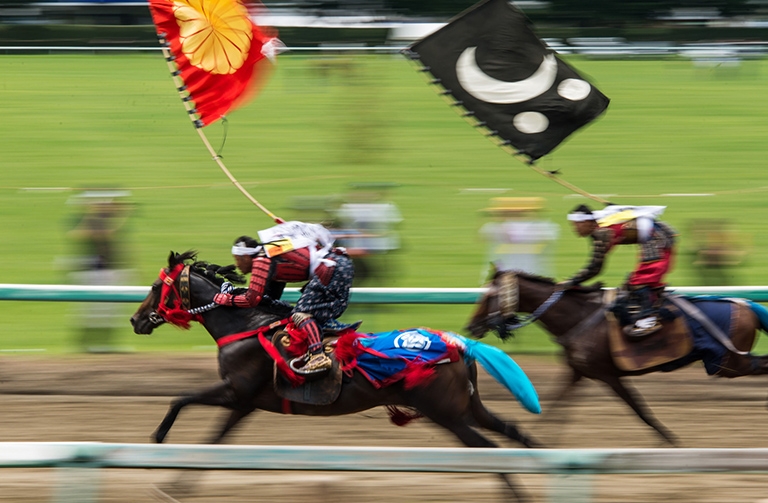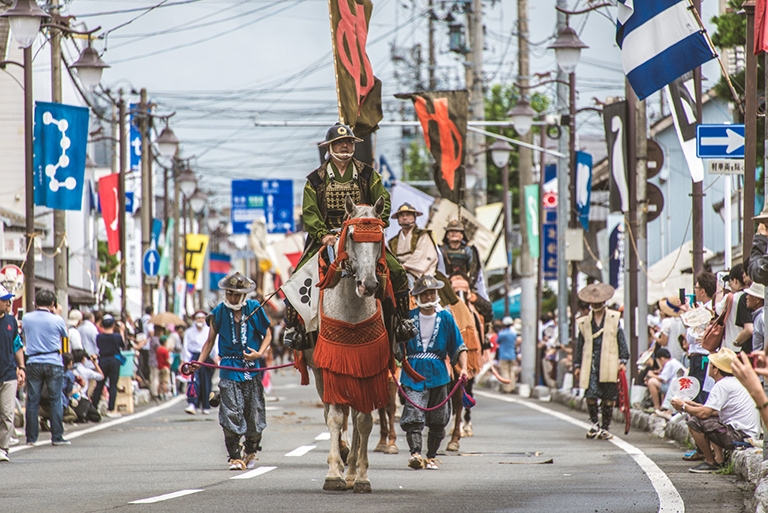
Men dressed in armor take part in a procession at the Soma Nomaoi festival in Minamisoma, Fukushima Prefecture, in 2018. | JERFAREZA DAVIANO
Equine legacy
The history of Soma Nomaoi is believed to date back 1,000 years or so to a time when the founder of the Soma clan, Taira no Kojiro Masakado, introduced it as a form of military exercise. The man who currently plays the leading role at the festival each year is Michitane Soma, a descendant of Soma clan chiefs whose lineage can be traced back 34 generations.
Historical evidence of the event can be traced back to around 400 years ago. Its format has changed several times over the course of its history.
“Samurai society lost a lot of influence between the bakufu era (of the Tokugawa feudal government) and the Meiji Era (1868-1912),” says Fumihiko Futakami, a curator at the Minamisoma City Museum. “As the Soma Nomaoi festival was an event founded by the Soma clan — a family that lost its samurai status during the Meiji Era — it wouldn’t have been surprising if the festival also disappeared. However, the Soma Nomaoi festival became an event that was affiliated with shrines and has been able to continue as a result.”
During the Allied Occupation, the GHQ didn’t look favorably at Shinto-related events that were evocative of Japan’s militarism leading up to and during World War II.
“Rather than hold an event that showed chivalry and was reminiscent of fighting, Soma Nomaoi was transformed into a peaceful sports festival,” Futakami says. “The races started as a result.”
However, Fukushima Prefecture’s close ties to equine culture extend beyond the Soma Nomaoi festival and numerous prehistoric artifacts linked to horses have been discovered in the region.
Archeological evidence suggests that horses first entered Japan from mainland Asia during the Kofun Period (250 to 552), eventually spreading to regions such as Nagano, Gunma and Fukushima.
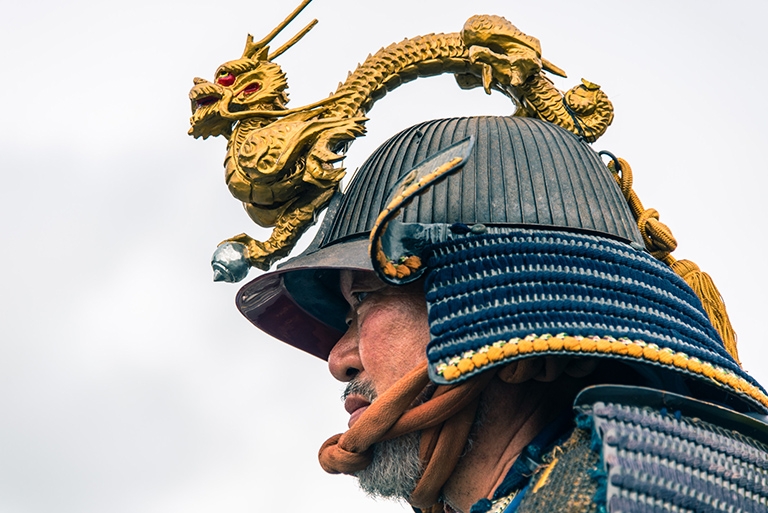
A man dressed in armor take part in a procession at the Soma Nomaoi festival in Minamisoma, Fukushima Prefecture, in 2018. | JERFAREZA DAVIANO
Horse-related artifacts have been discovered numerous sites in the Hamadori region along the Fukushima coast, including the late fifth-century horse-shaped haniwa figures from Soma, as well as fifth- to sixth-century horse tools from Minamisoma and a seventh-century wall painting in Futaba that boasts a clear depiction of horse riding figures — one of the best preserved of its time.
“People in the Hamadori region had a culture of making burial grounds inside caves, rather than in the ground where things would decompose,” says Makoto Hirasawa, a curator at the Fukushima Prefectural Museum in Aizuwakamatsu. “This resulted in a high proportion of immaculately preserved artifacts from around the end of the Kofun Period.”
The Fukushima Prefectural Museum has a number of prehistoric horse relics in its permanent exhibition.
“In the sixth century, horse tools were placed inside graves in places such as the city of Iwaki (in Fukushima Prefecture),” Hirasawa says. “Metals were rare at the time, so finding these items inside a grave is definitely a sign of social standing. Horses weren’t used by commoners at the time and owning a horse was more a status symbol than anything else. To own a horse in the Kofun Period was a representation of authority. Thereafter, horses were primarily used for transport and documents exist relating to their sale.”
Fumihiko Murai, a curator at the Equine Museum of Japan, says that various globalization movements had a significant impact on horse culture in Japan.
“In the Kofun Period (when horses entered Japan) and then later in the Meiji Era (when domestic horses were replaced with European horses), there was a general perception that horses should be larger and, as a result, the number of so-called native horses in Japan declined.”
Eventually, breeds such as the Akita, Sendai and Nanbu horses disappeared altogether.
In the 20th century, Murai says the rise of mechanization in the agricultural sector effectively ensured that the domestic horse population was pushed to the wayside.
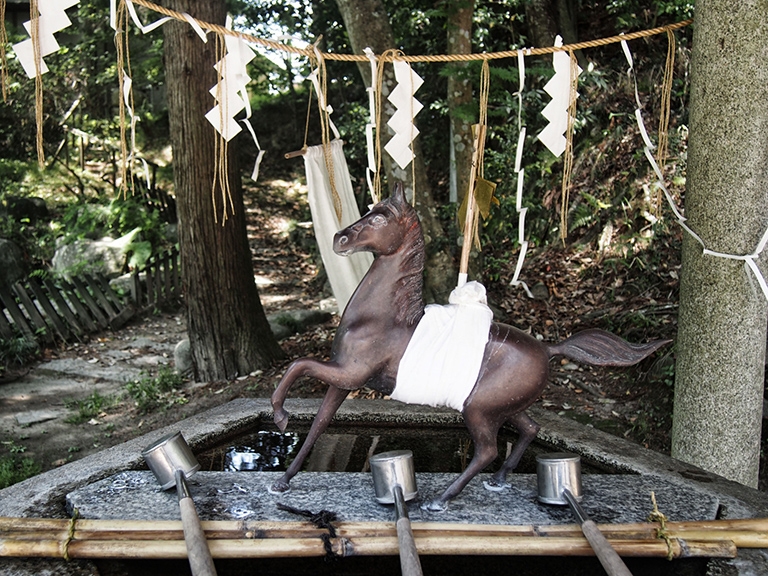
Revered animal: One of several horse effigies at Nakamura Shrine, one of three shrines that are central to the Soma Nomaoi festival in Fukushima Prefecture. | MANAMI OKAZAKI
Spiritual steeds
In religious terms, some believe that horses are carriers of the gods. The nomakake ritual that is performed at Odaka Shrine on the third day of the Soma Nomaoi festival reflects such beliefs.
Futakami says the nomakake ritual is important for a number of reasons.
“The Soma Nomaoi festival is held in Haramachi,” he says. “The site was really just a large field in the Edo Period (‘hara‘ means ‘field’ in Japanese) and the banks surrounding the pasture land typically contained several hundred wild horses. In the past, samurai on horseback would chase some of these horses into Odaka Shrine and that’s why the festival has been given its name — ‘nōma‘ is ‘wild horse’ in Japanese, while ‘oi‘ means ‘to chase.’
“On the third day of the festival, locals would catch horses inside the precincts with their bare hands and present them as offerings to the shrine. The Soma lord would then pray for things like peace and prosperity. Such prayers lie at the heart of the festival and yet its aesthetic is so majestic, it historically attracted a steady stream of visitors.”
Shinme are sacred horses that are offered to the gods at Shinto shrines. The practice of horse dedication is believed to date back as far as 1,200 years.
“Of all the animals that humans owned, horses were considered to be the best, and that’s why they were typically offered to the gods,” Murai says. “Shinto typically seeks to purify and protect against calamity, and so horses were seen as talismans — a bridge between our world and the world we can’t see.”
As horses were rare in the early part of Japan’s history, equine illustrations were painted on wooden boards called ema (literally, “picture horse”) and artifacts that date back to the Nara Period have been uncovered by archeologists.
In the Muromachi Period (1392-1573), the shape and motifs depicted on the ema began to broaden and include other figures.
From the 14th century to the beginning of the 17th century, ema also started to appear in temples, not just shrines. Even today, places of worship nationwide are covered in wooden plaques that comprise hopes and words of gratitude scrawled on the back.
Stable relationships
While horses in Japan have historically been used as work animals, Minamisoma residents consider them to be more like companions. Indeed, it’s worth noting that many of the horses that are used in the Soma Nomaoi festival are former racehorses that have been rescued from an unfortunate fate.
“Racehorses usually retire at 4 or 5 years old — basically at junior high school age if you think of that in terms of human years,” Futakami says. “Most of them aren’t simply put out to pasture until they reach old age, they’re sent to the slaughterhouse and turned into meat. Horses that are used in the Soma Nomaoi festival have often been given a second life in this regard. Their owners typically love their steeds and consider them to be family.”
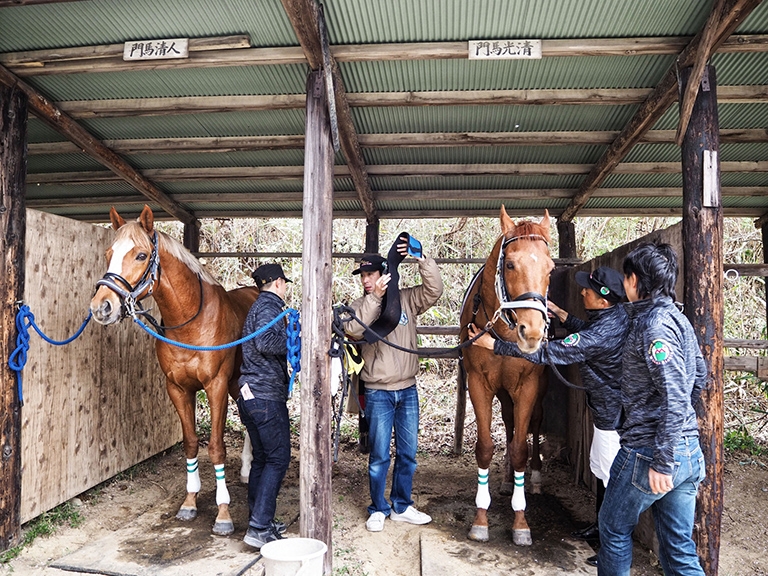
Men prepare horses for a race at the Soma Nomaoi festival in Minamisoma, Fukushima Prefecture. | MANAMI OKAZAKI
“The Soma Nomaoi festival is extremely important to the local community,” says Shohei Yoshida, a young rider who is saddling some thoroughbreds with his friend, Hiroshi Watanabe. Like most participants, they have regular day jobs, and like to ride their horses before and after work.
“Horses are great observers of humans,” Yoshida says. “They’re fascinating because they listen to us even though they’re bigger than us.”
Unlike most people who take part in the Soma Nomaoi festival, Katsuo Fushimi is a retired professional horse rider and a descendent of a lineage of horse traders.
Fushimi first took part in the festival more than 50 years ago when he was just 14 years old. His current house in Haramachi includes a large corral and riding area, as well as a wooden stable that dates back to the Edo Period. An impressive collection of 30 saddles sits in his attic, some from the Muromachi Period, near a row of Edo Period armor.
“The Soma Nomaoi festival is a part of me,” Fushimi says, feeding one of his thoroughbreds some pieces of carrot. “Even when I was living in Shiga Prefecture for a while, I traveled eight hours to make it back for the weekend. Nowadays, I ride my horses from first light. I head for the mountains, do a bit of jumping and run them around for an hour. It’s become my hobby.”
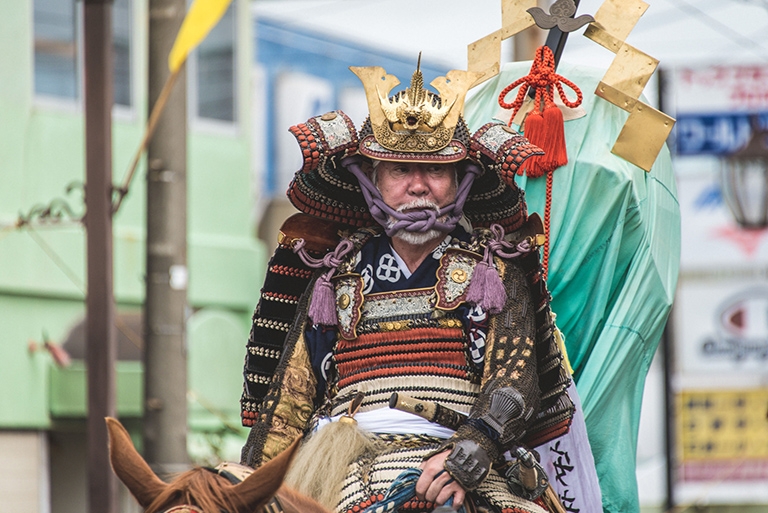
A man dressed in armor takes part in a procession at the Soma Nomaoi festival in Fukushima Prefecture. | JERFAREZA DAVIANO
Declining horsepower
While Minamisoma retains an obvious love for horses, the future of the festival remains unclear, with the number of participants falling year by year.
“Performing arts based on horses are usually celebrated in the format of a festival and, if these festivals didn’t exist, it’s highly likely the culture surrounding the animals wouldn’t survive either,” Murai says. “From the Edo Period to the Meiji Era, such events were used as a means to garner solidarity within villages and foster competitiveness with their neighbors. From now, such festivals will have to survive by continuing in a different format.
“It used to be that local communities would retain agricultural horses that could be used in the festival, but many parts of Japan are now urbanized and have no horses left at all. It comes down to choosing progress over tradition or the other way around.”
Futakami has seen the dwindling numbers with his own eyes. “In the past, 10 horses participated in 10 separate races at the festival,” he says, adding that most of the animals were agricultural.
“These days, however, retired racehorses from the central racetrack are used in the festival,” he says. “The agricultural horses were like ordinary cars and then, suddenly, Formula One racing cars were introduced. On top of this, the riders wear heavy armor while carrying giant flags. It requires a lot of skill.
“It’s really quite dangerous. Up to 500 horses take part in the procession and the flags are constantly fluttering in the breeze. There certainly aren’t too many situations like that. Horses are really sensitive, and some animals become easily spooked in unusual surroundings.”
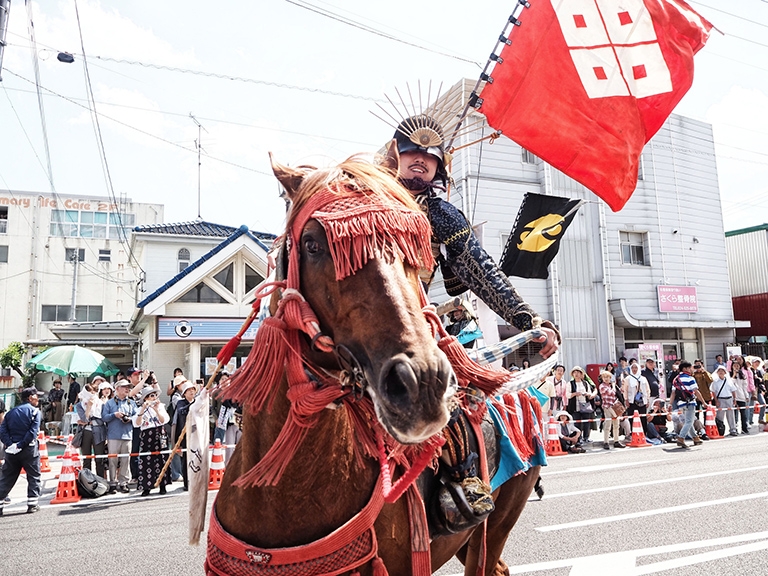
A Nomaoi participant shows off his horse-riding prowess in the city of Fukushima. | MANAMI OKAZAKI
The festival is also something of a financial burden on many families in Minamisoma. It isn’t cheap to look after the horses, while the cost and maintenance of equipment never seems to end.
The region has also been negatively affected by the triple disaster that occurred in the wake of the Great East Japan Earthquake in March 2011.
The coastal Fukushima region was partially inundated by the tsunami that resulted from the quake, suffering heavy damage. Around 1,770 residents are thought to have died from causes related to the disaster in the Soma region. The tsunami also swept away a lot of armor and equipment that was necessary to hold the festival.
What’s more, residents from many regions that participate in the festival — namely, Odaka, Namie, Okuma and Futaba — fell into the 20-kilometer exclusion zone surrounding the damaged Fukushima No. 1 nuclear power plant, and a number of Soma Nomaoi participants were caught up in the evacuation.
In 2011, Odaka Shrine lay within the restricted area so organizers were forced to use Taka Shrine located on the periphery of the prohibited zone instead.
The festival also included a memorial in 2011 for those who lost their lives in the disaster, including one dedicated to a young Soma Nomaoi participant.
In a stirring 2011 speech, Michitane Soma referred to the horses of the region as “invaluable,” saying that both horses and riders would “stand together in a spirit of unity toward recovery.”
While most of the animals in the exclusion zone were culled in the months after the quake, locals went to great lengths to save some of the horses — such is the importance of the festival to the region.
However, many residents haven’t returned to their former homes since restrictions were lifted, leading Futakami to question the festival’s future.
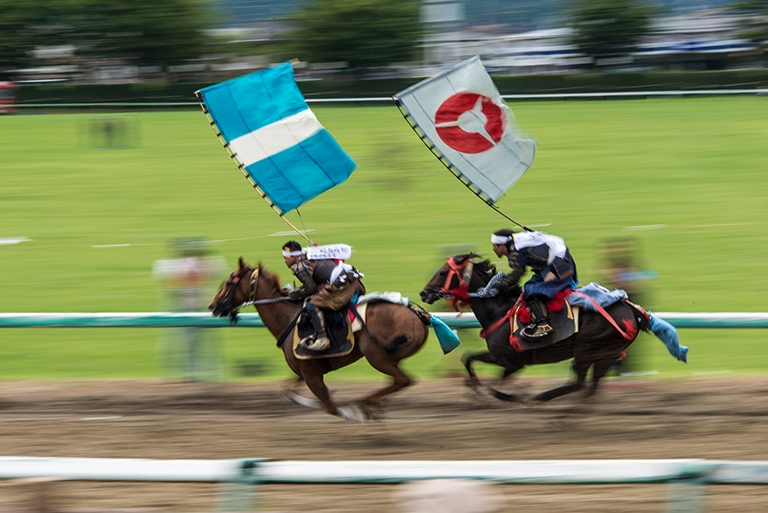
Men ride horses around Hibarigahara racetrack on the second day of the Soma Nomaoi festival in Fukushima Prefecture in 2018. | JERFAREZA DAVIANO
With fewer families living in the region following the 2011 disaster, Futakami isn’t seeing the next generation of festival participants coming through. An increasing number of children who had once lived in the region have never participated in the event before, leaving a dwindling number of young people who can continue to enter the festival behind.
“We might even need to rethink the festival’s structure,” he says.
And even if the festival continues to struggle to attract as many participants as it used to, Yoshida believes the region’s love of horses will live on.
“While we love horses, the Soma Nomaoi festival is particularly special,” he says. “We want to preserve it as part of our identity. Our understanding of the rites associated with the festival has been passed down from generation to generation, and therefore it’s extremely important to us.”
